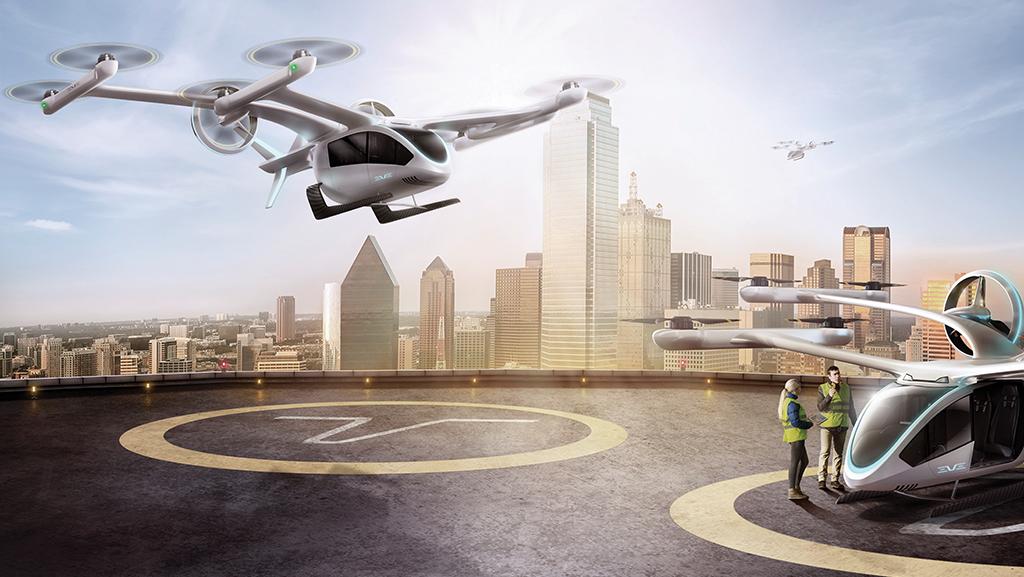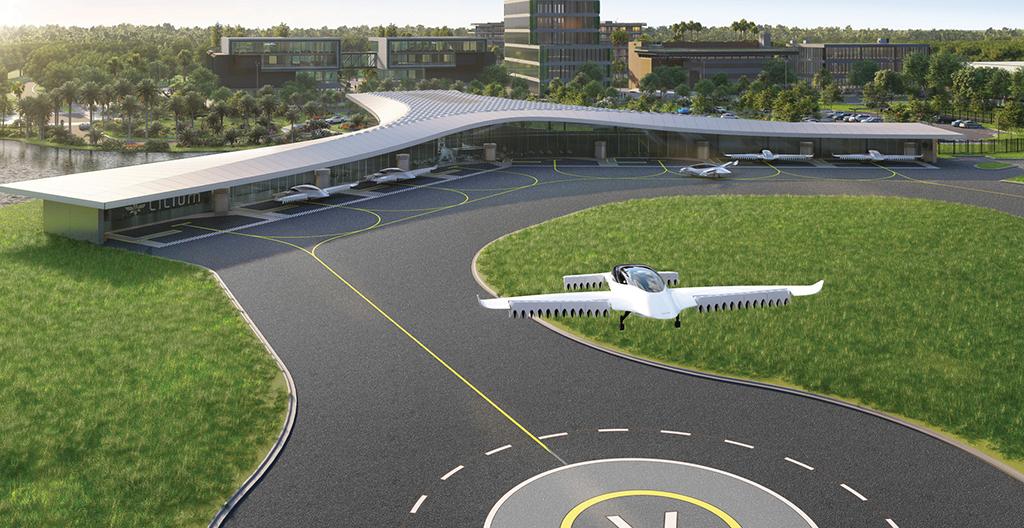
Progress over the last few years has pushed the advanced air mobility market from an exciting prospective technology to an established segment that will begin operations sooner rather than later. Chinese startup EHang is expecting airworthiness certification of its EH216 autonomous air vehicle from the Civil Aviation Administration of China this year, and vertical lift companies such as Joby Aviation and Volocopter are targeting operations by the end of 2023.
As advanced air mobility (AAM) vehicles dash toward the certification finish line, the industry is turning its focus toward developing the necessary infrastructure for operations and maintenance. Electric vertical-takeoff-and-landing (eVTOL) manufacturer Lilium announced plans in January to work with infrastructure specialist Ferrovial to build a network of vertiports in the U.S. Meanwhile, on the other side of the Atlantic, Ferrovial announced plans in February to develop a network of more than 20 vertiports in Spain, and Skyports is collaborating with AAM providers through several joint projects to develop and integrate vertiport operations. Skyports is also working to build a vertiport in Singapore in anticipation of Volocopter’s 2023 launch.
In addition to terminal and gate areas to process passengers, these vertiports will house infrastructure for battery charging and maintenance. According to Duncan Walker, CEO of Skyports, the volume of throughput for vertiports is expected to be very high, so efficiency of turnarounds will be key for operators.
“These vehicles are electric, so it’s about fast charging,” he says. “One of the challenges with charging things quickly is generation, so you’re limited by the rate at which a battery can adopt charge. All of the vertiports have, starting at one end, a relatively high electricity supply. You’ve got to have the grid capacity there to plug it in. And then there’s the transformers, which take electricity from the grid and deliver it to the vehicles in a way that is efficient but doesn’t blow up all the batteries.”

Since most AAM startups are targeting urban operations, one common concept in vehicle renderings has been the idea of vertiports located on top of tall buildings. Although an infrastructure of rooftop heliports already exists in many urban areas, Walker notes that simple repurposing may not fit the bill for eVTOL operators for several reasons.
“The reality is that repurposing is often very challenging because either the vertiports or heliports aren’t in the right place, or they were never designed for higher-volume passengers and higher-volume traffic,” he says.
“There’s obviously lots of heliports up on buildings. They’re typically emergency heliports or helipads, which serve a purpose if you need to get one or two emergency responders down to the building very quickly, but when you start moving the public and high-volume passengers through, the cost of the journey is often quite bad,” he adds, noting that passengers might need to tackle obstacles such as hatches, ladders or equipment. As a result, Walker says, companies such as Skyports will need to approach vertiport design through a combination of repurposing structures and building from scratch.
New Approaches to Maintenance
In addition to the challenges of operating within an urban environment, the limited range of eVTOLs will require operators to rethink their approach to maintenance. According to Andre Stein, CEO of Eve, EmbraerX’s urban air mobility spinoff, operators will need to rethink their approach of relying on a more decentralized organization.
“[eVTOLs] don’t have a lot of range, so it’s not like you can fly to an MRO far off and do your base or line maintenance,” Stein says. “You need to be close to where you are actually acting and the people who will be performing these tasks.” Stein notes that Eve and other AAM vehicle manufacturers have been engaging in discussions with MROs about how vertiports will play into turnarounds and heavier maintenance.
One benefit will be that eVTOLs are simpler to maintain compared with traditional aircraft. According to Lilium, the Lilium Jet has approximately 1,000 times fewer individual parts than a typical Airbus or Boeing aircraft, simplifying maintenance activities, maintenance ground times and the number of necessary spares. Stein notes that this will also be the case for the eVTOL that Eve is developing.
According to James Richmond, urban air mobility lead at Atkins, the technological differences of eVTOLs will not be the only factor that will affect maintenance compared with traditional aircraft. “The majority of emerging use cases in this market rely heavily on high utilization, and therefore designing a maintenance model to suit this—while upholding current levels of safety and resilience—will be key to ensuring eVTOL operations are scalable and commercially viable,” he says.”
Richmond suggests that a shift from “hard time” approaches will be necessary to combat natural inefficiencies and wasted time on the ground. These, he says, will include greater use of embedded sensors and data for real-time conditional monitoring beyond what the industry uses today. “The toolbox of the future will certainly contain more ones and zeros, and the ability to remotely do and share work will reduce the need for eyes on the apron,” he says.
Data-Driven Operations
To leverage data and get information into the hands of mechanics working on eVTOLs, Eve plans to use EmbraerX’s Beacon platform, which is designed to connect aftermarket and supply chain resources with technicians to simplify unscheduled maintenance.
“I think this digital analytical data will play a key role in maintenance and other services for the aircraft,” says Luiz Mauad, vice president of services and fleet operation at Eve. “The potential of prognostic and health monitoring are huge. Not only will the aircraft data be important, but the data generated on the ground will also be important for maintenance and the services and support.”
Stein notes that a digital approach will be a crucial aspect of thinking about the AAM ecosystem as a whole. “You might have potentially a hundred of these eVTOLs flying in a given area, so we need to rethink everything we’ve learned on how to play with the logistics and how to become more and more digital, and how to minimize the workload that either mechanics or anyone that attends the aircraft should have access to,” he says.
Stein also points out that maintenance providers will need to prepare mechanics to adapt their skill sets for eVTOLs. “It’s not like we didn’t have electrical parts in aircraft before, but not to this level,” he says. “Now we are talking about big batteries—high voltage—that are different from anything we’ve seen in aerospace before. Even in terms of technical skills, there are some new skills that we need to think about. We are talking about more autonomous systems. All that is new to the industry.”

“Maintenance technicians will almost certainly need new type ratings to match the new aircraft type, and given the divergence we see in some of the technologies and design configurations, there won’t be a one-size-fits-all approach,” Richmond says. “The availability of suitably qualified engineers and technicians to perform MRO operations could present a blocker to the high utilization and scaling required. A leaner, more centralized approach to damage inspection and triage may provide an answer.”
Richmond suggests that an essential component of this new approach could be remote “digital hangars,” such as damage scanning and virtual or augmented reality tools that have been gaining traction in the MRO industry.
According to Lilium, it is combining “high digitalization” with practical on-the-job training to familiarize pilots and technical personnel with the Lilium Jet. It has been working with MROs to create a maintenance program that it says will ensure high aircraft availability at the lowest cost possible to make the service accessible. As part of its European Union Aviation Safety Agency certification, Lilium is working to develop the relevant maintenance data and manuals.
Ecosystem Collaboration
Stein notes that Eve has had maintenance in mind from the beginning in the development of its eVTOL, and the startup plans to leverage parent company Embraer’s extensive aftermarket network and resources to prepare for operations that could entail up to 10 vehicle turnarounds a day.
“We talk about aftermarket, but we don’t start it after the market’s started,” he says. “Designing for maintainability is something that’s part of our DNA, and we are definitely putting that in everything we are doing. We really see service as a massive part of this market, as a blue ocean as well. We see ourselves in a very good position to connect the dots and provide service to all the urban air mobility players.”
Since eVTOLs are expected to begin operations soon, Richmond says manufacturers need to start thinking about maintenance. “The time to act is now,” he says. “Decisions could be locked in during the vehicle design phase that prove costly in terms of how the overall system performs and scales. The success of future operations relies on a system-of-systems approach now with all stakeholders—across multiple sectors—working together.”
“There’s a lot of challenge, of course, but we are cooperating with a lot of players inside this ecosystem to understand and develop the right services and the right support of this new ecosystem that we are building,” Eve’s Mauad says. “It’s going to be huge in terms of scale when you compare with the current service of aviation that we have today.”
In addition to a project it launched in December 2020 with Airservices Australia to develop urban air traffic management solutions, Eve is working with a consortium of stakeholders—including Skyports—to develop an urban air mobility concept of operations in the UK as part of the UK Civil Aviation Authority’s Future Air Mobility Regulatory Sandbox. Meanwhile, Skyports and Atkins are working together on the UK government’s Future Flight Challenge, which is exploring the feasibility of air taxi service in the South West region. The Future Flight Challenge is expected to take 18 months and seeks to culminate in a series of full-system demonstrations in live airspace across the region.


